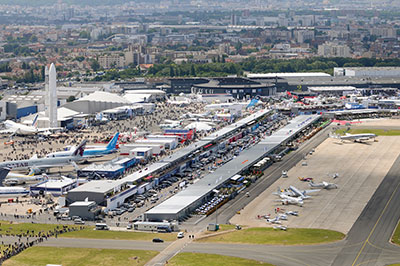
Features
Operations
Alternate Approach: Air show economics
This year the Paris Air Show opens the gates for the 50th time.
May 6, 2013 By David Carr
This year the Paris Air Show opens the gates for the 50th time. Paris, which celebrated its 100th anniversary in 2009, got a dry run as an add-on to the Paris Automobile Show in 1908 before becoming the first exhibition devoted exclusively to aircraft one year later. If the numbers don’t add up that is because the show became a biennial event after 1924, and was halted during two World Wars. Paris remains the undisputed la vieille dame of aviation trade shows in an increasingly busy circuit.
 |
|
| For now, any pullback by corporate aviation and defence at broader trade shows will be offset by a stronger presence in the hotly competitive commercial sector. Photo: Paris Air Show
|
In a 2005 column, I wrote about the success of the National Business Aviation Association’s (NBAA) regional Business Aviation Convention & Exhibition (BACE) strategy for executive aviation conferences and exhibitions in Latin America, Europe and China, and predicted that limited trade show budgets, “must either be increased, stretched over even more events, or strategically invested.”
Since then, the popularity of BACE has soared while shows in order-rich India, Singapore and Dubai are gaining traction.
Exhibitors have become more strategic in where they invest, with executive aviation original equipment manufacturers (OEMs) either making token appearances at less targeted shows such as Paris and Farnborough or bypassing them altogether.
Defence companies are also becoming more selective or scaling back. There is another dynamic at play according to Emeric d’Arcimoles, chief executive of the Paris Air Show. “Due to the decreasing of the military budgets of the different countries involved in the exportation of their own production . . . now they say they have to compete more aggressively,” he told the New York Times.
While exhibitors are showing signs of trade show fatigue, it isn’t always apparent on the ground. Paris had a record-breaking 2,100 exhibitors in 2011 and will hit capacity again this year. Singapore, which holds its biennial show next February, is reporting 80 per cent of floor space has been snapped up.
The Canadian Business Aviation Association’s (CBAA) annual show has traditionally attracted heavy hitters such as Bombardier, Cessna, Dassault and, more recently, Embraer. Canada accounts for an estimated five per cent of the global market for private aircraft. That number is certain to shrink, but Canada’s geography and dependence on international economic activity will continue to make it a substantive market for OEMs.
“We know that OEMs have finite resources,” says Debra Ward, CBAA’s manager of marketing and industrial relations. “OEMs need to see a return on the time and cost of attending CBAA. We are responding by providing value along the entire chain.” For CBAA 2013 in Vancouver, that includes a private VIP event for OEMs, expanded education programs with sessions geared to pilots, flight managers and schedulers and beefed up networking opportunities.
Clearly, the industry understands the economics of air shows. Executive aviation is gravitating toward targeted shows. For now, any pullback by corporate aviation and defence at broader trade shows will be offset by a stronger presence in the hotly competitive commercial sector.
Smaller public shows that lack the prestige of a Paris or a Dubai but have been thrilling crowds since the barnstorming era don’t enjoy similar fallbacks. John Cudley, president of the International Council of Air Shows (ICAS) estimates there are between 300 and 325 such shows in Canada and the United States every year. They attract up to 13 million spectators and pump over $1.5 billion into local economies. This crowd does not click over the turnstiles to watch airplanes that can be spotted at any airport.
The U.S. Air Force has responded to sequestration budget cuts by grounding all non-essential flying, including goodwill appearances at local air shows. As a result, 50 shows have been cancelled and the ICAS is concerned that number could double if the military does not restore some level of participation. American hardware including aerobatic teams such as the Blue Angels continue to be a huge ticket in Canada, which means the impact of sequestration cuts will percolate north. Could similar cuts happen here with, say, the Snowbirds? The current government appears to understand the importance of Canadian symbols. Hopefully it also appreciates the economics of air shows and the value of goodwill.
David Carr is a Wings writer and columnist.